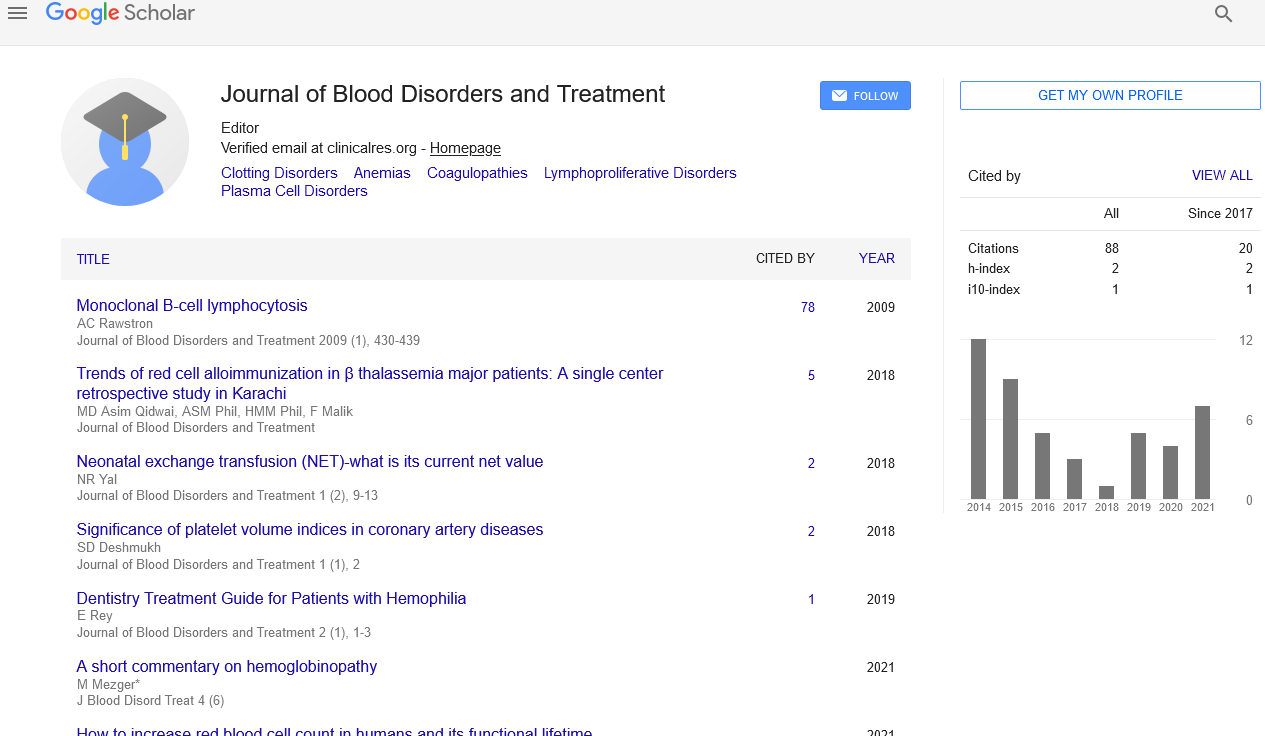Combined B-cell and T-cell disorders
Received: 04-Feb-2023, Manuscript No. puljbdt-23-6252; Editor assigned: 06-Feb-2023, Pre QC No. puljbdt-23-6252 (PQ); Accepted Date: Feb 25, 2023; Reviewed: 10-Feb-2023 QC No. puljbdt-23-6252 (Q); Revised: 12-Feb-2023, Manuscript No. puljbdt-23-6252 (R); Published: 28-Feb-2023, DOI: 10.37532/puljbdt.2023.6(1).03-04
Citation: Van A. Combined B-cell and T-cell disorders. J. Blood Disord Treat. 2023;6(1):03-04
This open-access article is distributed under the terms of the Creative Commons Attribution Non-Commercial License (CC BY-NC) (http://creativecommons.org/licenses/by-nc/4.0/), which permits reuse, distribution and reproduction of the article, provided that the original work is properly cited and the reuse is restricted to noncommercial purposes. For commercial reuse, contact reprints@pulsus.com
Abstract
B cells and T cells make up the cellular component of the immune system. Tradition has it that T cells are the lymphocytes responsible for killing other cells or organisms, while B cells are the lymphocytes that produce antibodies by developing into plasma cells (i.e. humoral defense).
Keywords
Bone Marrow; Hematopoietic; Cytopenias
Introduction
currently it is known that specific T-lymphocytes, or T-helper cells, aid in the maturation of immature B cells. Other T lymphocytes, or T-suppressor/cytotoxic cells, have the ability to kill while also preventing the growth of B cells. Therefore, it is potentially possible for any T-cell disorder to result in impaired B-cell function.
Lymphocytes, phagocytes, and the complement system are among the immune system's components that falter or are absent in people with immunodeficiency. Primary or indirect immune deficiencies are both possible. T-cell deficiency, B-cell deficiency, combined T-cell and Bcell deficiency, complement deficiency, phagocyte deficiency, and immunoglobulin A deficiency are the various subtypes of primary immunodeficiency. Di George syndrome, also called congenital thymic aplasia, chronic mucocutaneous candidiasis, hyperimmunoglobulin M syndrome, and interleukin-12 receptor deficiency are primary immune deficiencies that result in T-cell deficit.
Bruton agammaglobulinemia, also known as X-linked agammaglobulinemia, is a primary immunodeficiency that causes Bcell depletion. Severe combined immunodeficiency disease, WiskottAldrich syndrome, immunodeficiency with ataxia-telangiectasia, and Major Histocompatibility Complex deficiency are among the primary immunodeficiencies that can result in both T-cell and B-cell failure. Hereditary angioedema, C3 deficiency, membrane attack complex deficiency, and C2 or C4 deficiency due to autoimmune disease are some examples of primary immunodeficiencies that result in complement deficiency. Chronic granulomatous disease and leukocyte adhesion deficiency syndrome are two primary immunodeficiencies that can cause phagocyte deficit.
Lymphocytes, phagocytes, and the complement system are among the immune system's components that falter or are absent in people with immunodeficiency. These immunodeficiencies can be intrinsic, like Bruton disease, or secondary, like the immunodeficiency brought on by HIV infection. Primary immunodeficiency disorders are caused by inherent flaws in immune cells, such as phagocytes, complement related molecules, and T cells. The recurrence of pneumonia brought on by extracellular bacteria indicates a lack of antibodies. On the other hand, a deficiency in T lymphocytes may be the root of recurring fungal infections.
B lymphocytes and T lymphocytes are immune cells. Plasma cells that generate a lot of antibodies are created when B-cells undergo transformation. These immunoglobulins or antibodies work to combat extracellular bacteria. That explains why extracellular bacterial illnesses like pneumonia and otitis are more common in people with B-cell agammaglobulinemia.
Reduced serum concentrations of various immunoglobulin isotypes are a characteristic of the heterogeneous collection of inborn immunity errors known as Common Variable Immunodeficiency (CVID). With a wide spectrum of infectious and non-infectious clinical manifestations, CVID is the most common symptomatic antibody deficiency. It is known that a number of genetic and immunological abnormalities contribute to the pathogenesis of CVID. About 20% to 50% of CVID patients have monogenic defects as their pathogenesis, while some instances lack a clear genetic cause. Monogenetic abnormalities of CVID could be linked to deficiencies in molecules involved in B-cell receptor signaling or other pathways involving B-cell development, activation, and proliferation. Genetic flaws that inhibit various B-cell growth phases can affect the differentiation of B lymphocytes as well as other lymphocytes, which may contribute to the disorder's clinical and immunologic manifestations. The most common primary immunodeficiency disease, known as Common Variable Immunodeficiency Disorder (CVID), causes hypogammaglobulinemia, impaired production of certain Immunoglobulins (Igs) after vaccination, and greater susceptibility to infections. Patients with CVID exhibit a wide range of infectious and non-infectious clinical manifestations, including recurrent bacterial infections of various body sites, particularly the respiratory tract, inflammatory complications, autoimmunity, lymphoproliferation, and cancer.
T lymphocytes and B lymphocytes are part of the adaptive immune system, which can be further broken down into cellular and humoral reactions. T cells play a key role in the cellular immunological response, which controls intracellular infections by viruses, parasites, and mycobacteria. Activated B-cells create antibodies, the main component of the humoral response, to help stop the spread of extracellular pathogens. B-cells can activate antigen-specific T-cells for a cellular immune response, whereas an effective B-cell antibody response relies in part on T-cells activating B-lymphocytes. Tlymphocyte and B-lymphocyte responses are not mutually exclusive. Thus, various degrees of cellular and humoral defense may be impacted by defects in either cell type.
Genetic flaws that cause T-lymphocyte dysfunction are the cause of combined immunodeficiency disorders. These patients are vulnerable to opportunistic infections as well as skin and sinopulmonary infections caused by bacterial, viral, and fungal organisms because B cells require T-cells to make antibodies. In some syndromes, immune dysregulation can result in autoimmune illness and autoinflammation. A Severe Combined Immunodeficiency (SCID) diagnosis is a medical emergency because it can lead to death before the age of two years without treatment. Older individuals may exhibit certain well-known primary immunodeficiencies like Wiskott-Aldrich Syndrome, Hyper IgE syndrome, and Ataxia Telangiectasia.





